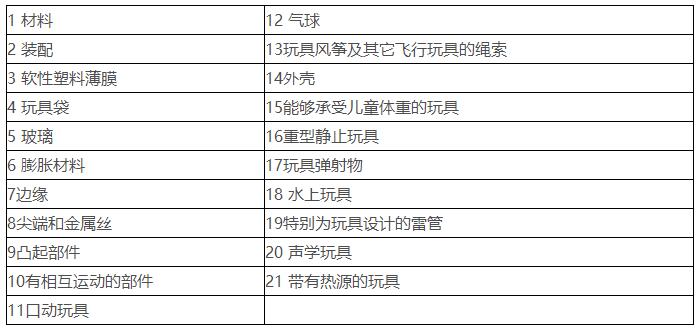Basic introduction
EN71 is the norm for toys in the EU market. Children are the most concerned and loved group in the whole society. The toy market that children generally love is developing rapidly. At the same time, various types of toys cause harm to children from time to time. Therefore, countries around the world The requirements are becoming increasingly strict. Many countries have established their own safety regulations for these products, and production companies must ensure that their products meet relevant standards before they are sold in the region. The manufacturer must be held responsible for accidents caused by production defects, poor design or the use of inappropriate materials. As a result, the EN71 certification law for toys was introduced in Europe, and its significance is to adopt EN71 standards to technically regulate toy products entering the European market, thereby reducing or avoiding the harm of toys to children.
Latest revision
EN 71-1: 2005 + A9: 2009 released the latest revision 9, approved by CEN (European Committee for Standardization) on May 23, 2009, and finally released by CEN Technical Committee CEN / TC52 "Toy Safety" in July 2009 Version (EN 71-1: 2005 + A9: 2009), covering previously published amendments. The European Commission officially published the new toy safety coordination standard EN71-1: 2011 in the Official Journal of the European Union (OJEU) on June 18, 2011. The new harmonized standard is based on the new toy safety directive 2009/48 / EC (effective date: July 20, 2011). According to the requirements of the new toy safety directive, all toys placed on the EU market after July 20, 2011 must comply with the EN71-1: 2011 new harmonized toy standard.
The new version (EN 71-1: 2005 + A9: 2009) replaces EN 71-1: 2005 + A8: 2009 requiring its member states * to adopt and publish the new version as a national standard, withdrawn at the latest in January 2010. This conflicts with national standards.
The amendment has not been published in the Official Journal of the European Union. The process of adopting and changing standards is very complicated. First, national authorities, laboratories, and consumer organizations among the industrial representatives of CEN (European Committee for Standardization) discussed and agreed to change the standard, and then CEN issued the EN 71 standard. However, the standards issued by CEN may not be able to become a unified standard. It will become a uniform standard only after it is published by the European Commission in the Official Journal of the European Union. It was only after the standard was published in the Official Journal of the European Union that it was accepted and met the basic requirements of the Toys Directive. Therefore, the standard needs to be issued twice before becoming a regulation:
1. Published by CEN (European Committee for Standardization);
2. Can be used as a unified standard after it is published by the European Commission in the Official Journal of the European Union.
A7 revision In addition to adding early warning requirements for rocking horses and similar toys, editorial amendments were also mainly made. A large description of age warnings for toys that are not suitable for children under 36 months has been added.
The A8 amendment clarifies the safety requirements for magnet toys. However, this requirement does not apply to functional magnets (such as motors, relays, speakers, etc.) and all magnets / electrical test devices with a magnetic flux coefficient of less than 50kG2mm2 in electrical or electronic component toys, or those that cannot fully enter the small object measuring cylinder. Magnet / electrical test device. The packaging and instructions for use of the magnet / electrical test device shall bear warning signs:
"Warning! Not suitable for children under 8 years of age. This product contains small magnets. Swallowing magnets can form intestinal adhesions that can cause serious injury. If you swallow the magnets by mistake, consult a doctor immediately."
The revised A8 version also applies to the safety warning requirements for magnet toys in EC Directive 2008/329 / EC 2,3.
Certification standards
EN 71 Part 1
1.EN 71 Part 1: 2005 + A9: 2009-physical & mechanical Test
(a) Without Sound module
(b) With Sound module
(c) Earphone with Sound
(d) 7000 Cycles Switch Test for Chest
(e) Ride-on Toys
(f) Mouth-actuated Toys
Physical and mechanical properties This part mainly includes drop detection, small parts detection, sharp edge detection, tension detection, pressure detection, seam detection, ear, nose, eye tension, and torque detection. General requirements for physical testing:

EN 71 Part 2
2.EN 71 Part 2: 1993-flammability Test
(a) Finished Product
(b) Pile fabric or material
EN 71 Part 3
3.EN 71 Part 3: 1994-Toxic Elements Test (19 Toxic Elements Results)
Toxic metal dissolution test (test results of 19 toxic metal elements)
Lead mercury cadmium chromium arsenic selenium barium antimony etc
EN 71 Part 4
4.EN 71 Part 4: Experimental Set for Chemistry
EN 71 Part 5
5.EN 71 Part 5: Chemisty Toys (Sets) Other than Experimental Sets
EN 71 Part 6
6. EN 71 Part 6: Graphical Symbol for Age Warning Labelling.
EN 71 Part 7
7.EN 71 Part 7 Finger Paints
(a) Colorants
(b) Preservatives
(c) Binding agents, extenders, humectants and surfactants, ingredient review
(d) Limits for the of Transfer certain elements
(e) Limits for primar aromatic amines
(f) Ethanol
(g) pH value
(h) Product information & Container
EN 71 Part 8
8.Swings, slides and similar toys for indoor and outdoor home entertainment
EN 71 Part 9
9.General requirements for organic compounds in toys
EN71-9 General Requirements for Organic Compounds-specifies the total amount of migration of toxic compounds present in each toy or toy material in the following exposure modes: contact with mouth; possible ingestion; skin contact; eye contact; inhalation.
Products within the scope of the standard include toys designed for children under 3 years of age (because these toys may be chewed by children in the mouth) and products designed for older children (these products may reach children's mouth , Skin, or inhaled by children.)
Specific product or toy components within the scope of the standard include:
Toys that could be chewed by children under 3 years of age
Toys or accessible toy parts weighing less than or equal to 150 grams for children under three years of age,
Toys and accessible toy parts for children under three
Oral contact parts of mouth-moving toys
Toy on mouth or nose
Children accessible toys
Patterning device parts used as or used in toys
Toys and accessible toy parts for indoor use
Toys and accessible toy parts for outdoor use
Toys or toy parts that mimic food designs
May leave traces of solid toy material
Colored liquids easily accessible in toys
Colorless liquid easily accessible in toys
Model clay, toy clay or similar products, except for chemical toys mentioned in EN 71-5
Balloon manufacturing parts
Sticky imitation totem
Imitation jewelry
The scope of restricted substances is particularly wide, including flame retardants, colorants, aromatic amines, monomer substances, solvent migration, inhalable solvents, wood preservatives (indoor and outdoor), other preservatives and plasticizers.
EN 71 Part 10
10. Sample preparation and extraction of organic compounds
EN 71 Part 11
11.Analytical methods of organic compounds
EN 50088
EN 50088-Electric Toy Safety Test
EMC Directive 89/336 / EEC
EMC Directive 89/336 / EEC European Community EMC Test
(a) Motorised Toys EN 55022
EN71 details
EN71-1: Toy Safety-Part 1: Physical and Mechanical Properties
EN71-2: Toy Safety-Part 2: Flame Retardant Performance
EN71-3: Toy Safety-Part 3: Transfer of Certain Elements
EN71-4: Toy Safety-Part 4: Test Equipment for Chemical and Related Activities
EN71-5: Safety of toys-Part 5: Chemical toys (except test devices)
EN71-6: Toy Safety-Part 6: Graphical Representation of Age Marks
EN71-7: Requirements for finger paints
EN71-8: Rocking, sliding and similar toys for indoor and outdoor home entertainment
EN71-9: General requirements for organic compounds in toys
EN71-10: Sample preparation and extraction of organic compounds
EN71-11: Analytical methods for organic compounds
 Hot Line
400-800-6106
Hot Line
400-800-6106
